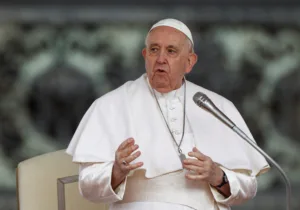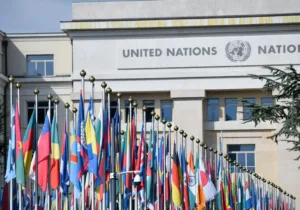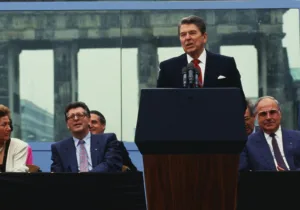Vladimir Putin has launched attacks across Ukraine, recognized parts of eastern Ukraine as independent, sent Russian “peacekeepers” deep into Ukraine either to digest yet another chunk of his neighbor or to fully absorb it, and unleashed a storm in Europe. Although they cannot be seen from Kyiv, there are faint traces of silver linings in these storm clouds.
NATO’s Renewed Unity and Importance
Because of Putin’s actions, the NATO alliance is more united than at any time since 9/11—and more relevant and more important than at any time since 11/9.
The transatlantic community worked to address numerous post-Cold War crises. For example, NATO members formed the core of the campaigns that liberated Kuwait, flattened the ISIS caliphate, and protected Libyans from their own government; NATO contained the war in Bosnia and protected Kosovo; and NATO helped avenge al-Qaeda’s 9/11 attacks. Through all of this, NATO remained an important insurance policy just in case Moscow reverted to its old ways. And here we are.
Indeed, since its founding in 1949, NATO has been in the insurance business. Prudent people hope they never have to use insurance, but they realize that paying a little each month or each year protects them against having to pay a lot—or losing everything—if disaster strikes. The same is true in the realm of international security.
The deterrent represented by Article V of the North Atlantic Treaty is an insurance policy against worst-case scenarios. This NATO insurance policy—this tool for deterring aggression against its members, building political consensus, promoting military interoperability, and containing war—is something pre-World War II Europe didn’t have. NATO embodies one other thing pre-World War II Europe didn’t have: America’s commitment. For NATO’s European members, NATO is a security guarantee backed by America. Without that guarantee, there’s no security, as history has a way of reminding those on the outside looking in, from Cold War Hungary to post-Cold War Ukraine. And for America, NATO is a hedge against another European-wide conflict triggering another great-power war.
It’s impossible to read Putin’s mind, but the rapidity and unity of NATO’s response to his buildup and bluster surely came as a surprise to the Russian strongman.
The 30-member alliance swiftly rejected Putin’s December diktat—and then set about the task of bolstering its easternmost members.
The US has deployed B-52s to Britain, F-35s to Germany, F-15s to Estonia, thousands of troops to Poland and hundreds to Romania, approved a long-delayed sale of 250 M1A2 tanks to Poland, and surged the aircraft carrier USS Harry S. Truman to join carrier strike groups from Italy and France in a massive show of force in the northern Mediterranean.
Britain has deployed hundreds of troops to Poland and the HMS Defender to the Black Sea. Germany has sent troops to reinforce its contingent in Lithuania. France dispatched hundreds of combat troops to Romania. Denmark rushed F-16s to Lithuania and sent a frigate to the Baltic Sea. The Netherlands and Spain announced plans to deploy fighter jets to Bulgaria. And several allies have put key units on standby as NATO readied its rapid-response force for activation. As Gen. James Mattis puts it, “If we did not have NATO today, we would need to create it.”
Nor has the alliance limited its response within the NATO footprint. The US has formed an airbridge linking NATO bases with Kyiv, enabling the delivery of defensive weapons from North America, Britain, Estonia, Latvia, Lithuania, Poland, Turkey, and the Czech Republic. As the Wall Street Journal reports, the US has shipped tons of small-arms ammunition, mortar and artillery shells, antitank systems, and grenade launchers to Kyiv. Britain has delivered thousands of antitank missiles, trained 22,000 Ukrainian troops, and provided weapons systems and infrastructure for Ukraine’s coastal defenses. The Balts have sent Ukraine US-made anti-aircraft missiles and anti-tank systems. Poland is sending anti-aircraft weapons. Turkey has delivered ground-attack drones.
Of course, this may not be enough to preserve Ukraine. With a coiled-to-strike force of 190,000 Russian troops on and within its borders, Ukraine is not only maimed but also mismatched. Kyiv now faces a terrible choice: conventional warfare against a full-spectrum military force capable of flattening the whole of Ukraine; guerilla insurgency that will surely make Russia bleed (see the above paragraph) but will also turn Ukraine into a latter-day Bosnia; or capitulation that will limit further death and destruction but erase Ukraine’s sovereignty. With its reserve forces now being mobilized, Ukraine appears to have chosen that first option. It is a just and honorable course, but it will be bloody and brutal. What lies ahead for Ukraine—and what it has endured since 2014—challenge the very notion that there are silver linings to be found in the storm Putin has spawned. “War is hell” and “cruelty,” as Gen. William Sherman lamented.
Revival of Turkey-NATO Bonds
For individuals and nations alike, times of crisis have a way of putting things in perspective. That appears to be what’s happening for Turkey and NATO.
The longtime NATO member has been somewhat estranged from the alliance due to Turkish President Recep Tayyip Erdogan’s authoritarian tendencies at home and wayward actions abroad. The most glaring was his 2017 decision to purchase and deploy—over Washington’s strong objection—Russia’s S-400 air-defense system. As a consequence, Turkey was thrown out of the F-35 consortium—a select group of US allies invited to participate in the production and deployment of one of the world’s most sophisticated stealth fighter-bombers. Understandably, Washington worried that the S-400 system—and its Russian trainers and technicians—would be able to tap into the F-35’s technology.
Washington was not only livid with Erdogan but also concerned about his drift into Putin’s orbit. Erdogan was equally furious with Washington. Yet Putin’s ongoing assaults on Ukraine’s sovereignty and territory have reminded these old allies that they have a common enemy and common interests. That’s what brought them together during Cold War I, and that’s what is pulling them back together in these early hours of Cold War II.
Not only has Turkey fallen in line with its fellow allies, not only has it delivered unmanned combat aerial vehicles (UCAVs) to Ukraine, but Ankara has also allowed Kyiv to begin producing Turkish-designed drones. Erdogan has served as one of Ukraine’s emissaries to Moscow. Ukrainian President Volodymyr Zelensky has leaned on Erdogan throughout the crisis, and Erdogan has called Putin’s actions “a clear violation of Ukraine’s political unity, sovereignty, and territorial integrity” and “unacceptable.”
As Putin tries to reconstitute the Russian Empire, Erdogan is realizing, finally, that Turkey’s future is far better served by its alliance with NATO—which has stood by Turkey for seven decades—than by a marriage of convenience with Russia—which is an ancient foe of the Turkish people, a serial violator of treaties, and a pariah state.
As Turkey comes in from the cold, it seems likely that Erdogan will give up Russia’s S-400s, which would allow Turkey to rejoin the F-35 partnership. This is not to countenance or forgive Erdogan’s actions, especially his authoritarian moves at home. But with Russia on the march, NATO and Turkey need each other—in Europe, the Black Sea, and the Mediterranean—just as they did during Cold War I.
Clarity at Home and Abroad
From Europe to America, Putin’s actions should cause the scales to fall from the eyes of those who believed resets and hushed promises of “flexibility” could deter aggression, who mockingly dismissed concerns about Russian revisionism, who pronounced NATO obsolete or brain dead, who soothingly assured us we could turn inward and focus on nation-building at home, who tried to use US troop deployments to settle geopolitical scores, who slashed NATO’s deterrent strength (see here, here, here and here). Putin’s actions have exposed these policies and positions as misguided. Some have recognized this; some have not.
Putin is not another Hitler. However, what Putin has set in motion serves as an echo of 1938. That was the year Hitler threatened war over German-speaking parts of Czechoslovakia and was rewarded at Munich for threatening to wage a war of aggression. Though not invited to Munich, Czechoslovakia was not silent. “Today it is our turn,” Czech Foreign Minister Kamil Krofta said, as a stronger, bigger neighbor gobbled up his country. “Tomorrow it will be the turn of others.” He was right.
There’s another echo here. Like history’s other revisionist autocrats, Putin masters in the double-standard and in contriving historical grievances. He labels Ukraine “Novorossiya,” a czarist-era term for Ukraine’s Russian-speaking regions. He laments how the collapse of the Soviet Union meant that “historically Russian territories with a historically Russian population, primarily in Ukraine, had found themselves living outside Russia.” He calls Ukraine “an integral part of our own history, culture, and spiritual space.” He claims Ukraine is building “an anti-Russia” and “stockpiling the latest weapons… Just imagine how Russia must live and carry on.”
This would be laughable if the stakes weren’t so high. Russia, which invaded Ukraine, has a $1.7-trillion GDP, a population of 145 million, 1.4 million men under arms, a $61.7-billion military budget, and 4,500 nuclear warheads. Ukraine, which was invaded by Russia, has a $153-billion GDP, a population of 44 million, 297,000 men under arms, a $5.9-billion defense budget, and zero nuclear weapons. In fact, Ukraine surrendered its nuclear arsenal in exchange for a commitment from Russia to “refrain from the threat or use of force” and respect Ukraine’s “independence… sovereignty and the existing borders.”
That’s a reminder that Putin—like his Soviet predecessors, like Hitler—doesn’t care about treaties.
Opportunity for Foreign Policy Consensus
Throughout American history, external threats have served as a powerful unifying force. The British army’s massacre of colonists in Boston and the British government’s “intolerable acts” united planters and merchants, farmers and city-dwellers, Jeffersonians and Hamiltonians. Imperial Germany’s “warfare against mankind” and diplomatic treachery spurred a pacifist America into the Great War. Japan’s “unprovoked and dastardly attack” transformed an isolationist America into a global military juggernaut. The communist bloc’s attempt to seize West Berlin and South Korea rallied Americans for the Cold War.
Just as the made-in-China pandemic proved that the People Republic of China’s internal political system is an international problem—and quieted those who convinced themselves that such a regime could somehow be reformed by access to Buicks and Kentucky Fried Chicken—what Putin is doing to Ukraine and in Ukraine confirms for the unsure and the naïve what Putin wants. And that is, as Churchill said of Putin’s predecessors, “the fruits of war and the indefinite expansion of their power and doctrines.” For Putin, that translates into a neutered NATO and a reconstituted Russian Empire.
Putin’s actions also point the way toward what America must do to prevent him from getting what he wants—and thus setting off a cascade of similar might-makes-right assaults in other parts of the world. Still, whether a critical mass of policymakers will take this opportunity to forge such consensus remains an open question.
Reason for Prayer and Preparation
“For the first time in history, there exists in peace an integrated international force whose object is to maintain peace through strength,” President Harry Truman explained when NATO was young. “We devoutly pray that our present course of action will succeed and maintain peace without war.”
A unified NATO can prevent Putin’s war from mushrooming into a continent-wide conflict. But now, as when Truman offered those words, there are limits to NATO’s reach and role—which is why NATO’s leaders and Ukraine’s people need our prayers.







 Live in the DC area? Sign-up for Providence's in-person events list!
Live in the DC area? Sign-up for Providence's in-person events list!